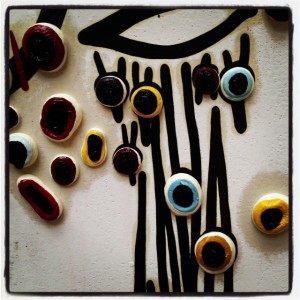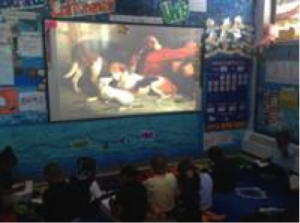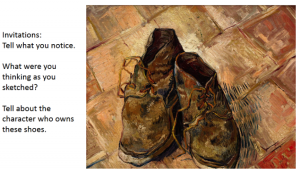During our first visual literacy consortium meeting this year, we began with time in the galleries. Each teacher found a work of art that reflected their own experience beginning the school year. Many found that the experience helped shed new light on the work ahead. Here are some excerpts from the conversation.
Charlice Culvert, art teacher
“Given the fourth floor to explore the concept of what were our expectations for the new school year and where was it going, I knew immediately that I would focus on the abstract art in the Long Gallery. Abstract art allows me to reflect more deeply than representational art; there are no boundaries for the interpretation.

Barbara Hepworth’s stone sculpture is located in front of a window, causing the black surface to seem even darker with the light behind shining through the openings. I thought about how to get through to the other side of the curriculum, expectations, students and everything the new school year brings; would there be surprises on the other side, would I be able to enjoy the journey? I could see some glimpses of what might be, but could not tell exactly what awaited me on the other side.
Next, I viewed John Walker’s, Untitled Collage NYC No5. With all its different textures, it reminded me of all the students who enter my classroom and all their different personalities. The complexity of one student could also be seen through this collage. We are all complex in our personalities. How do I respond appropriately to them all?

The last piece of art I viewed lacked a label so I gave it the title, All Eyes on Me. Scattered all over the painted are three dimensional circular shapes which are eye-like. Red forms, reminiscent of figures, stand facing outward. Black lines move through the composition conveying the feeling of jazz music. My students’ expectations are high, they are energetic and they demand attention. I need to be on my toes at all times.”

Nick Mead, 2012
Daron Cyr, kindergarten teacher
“Chaotic best sums up my year; lots of lines and colors that seem to never come together. I view visual literacy as a “safe” place for those colors, textures, and lines to play, arrange, rearrange, mingle, change, morph into something visually appealing. The eyes in the piece … like my 4 year olds eying everything – the good, the bad, my reaction, the day, the mood … all the eyes.
I hope to let their creativity shine unstifled with textures and tools in their desperate fingers. It’s a mindset really: That we are valuable thinkers and creators of ideas and art.
I sought abstract art because the lines and boldness were almost soothing – a means of decompressing and a way to visualize my room as an art form even amidst the chaos.

I gave my students their sketchbooks for the first time last week and asked them to do a self portrait – which was exciting and a great first time in their books. Last friday I put up A Couple of Foxhounds from the YCBA collection and after reading the painting together (which is getting better every week) I asked them to use only pencil (which normally would be “boring”) and either try to draw the painting, focus on their favorite part, or draw what it reminds them of.

I was in awe of how well my young and challenging learners handled it! Many copied the shadows and shapes in the painting but even more drew their own dogs or family because the dogs reminded them of home. Everyone was doing something and whether or not it was recognizable to me wasn’t as important as the fact that they were moved to draw something based on what they saw.
Next week I’m getting ready to start a “Work on Art” center as part of literacy time because it fits perfectly with their need for Oral Language but also because they are engaged and will enjoy choosing a picture card and spending time in their sketchbooks.”
Rebecca Looney, art teacher
” The piece I chose to talk about and connect with my students was Peter Howson’s Farewell, Farewell. I felt that this work would invite the most conversations about the back story of all that I looked at. Beginning this year, I’ve noticed conflicts between students occurring much earlier in the year than in years past. Usually they are one student against a couple of others, which seemed to be exemplified by the number of people in this painting. This painting would be a great bridge to talking about relationships and communication.”
Karen Williams, art teacher
“The beginning of the year can be exciting and intimidating at the same time: new students, new school procedures, new administrators, new colleagues, new materials – all new experiences to bring to a new year.
This past YCBA workshop was a reminder of what I took and want to keep from the summer institute.
The art room is a place where things can move S L O W.
The art room is a place where you observe, notice, question.
The art room is a place where individuality is honored.
Although the rush of school year can cause me to overlook these very important things, the meeting served as a good “huddle” time for us, as educators, to reflect on why we are doing what we are doing: To help our students, ourselves and others to learn, to grow and to deepen our experiences not only in art but in all other areas of life as well.”
Patti Darragh, reading specialist
Launching the Year
“As I wandered the galleries, thinking about starting the school year with my reading students, this painting jumped off the wall at me.

The Sense of Sight, Philippe Mercier
It emphasizes the power of a visual image. Just as the characters in this narrative are intent on studying this map, my students stretch and move their seats to get a better view of images I present to them.
Looking does not put my challenged readers on the spot. Everyone can look and looking naturally leads to thinking and talking.
I don’t know who is more amazed at students’ responses to art; me or the students themselves.
My advice- try it and be amazed!”
Please share your own experiences “launching” visual literacy this year.













